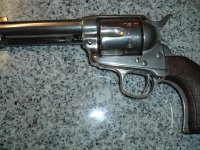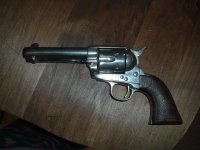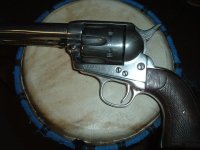Thirty years ago, it was commonly believed that any SA with the spring-loaded crosspin retaining the cylinder pin was "smokeless", even though such guns were made years before Colt warranted their guns for smokeless. I won't argue the 1900-19003 disparity, but I have been guided, in my shooting of vintage arms, by an article in a newletter I used to receive. The suggestion was that regardless of when a gun was made, if it was designed prior to the turn of the century (19th/20th), it should not be fired with smokeless powder. Now, this would consign a number of "smokeless" guns to wallhanger status, but I agree with the theory that, prior to WWI, there were relatively few guns made for smokeless powder, and even early guns that were intended from the start for smokeless (for example, low-numbered M1903 rifles), were not necessarily safe. Just a thought, before risking an interesting artifact of American and firearms history.




